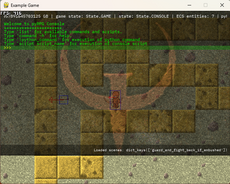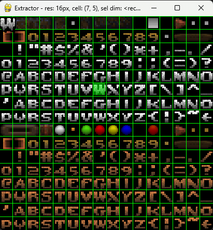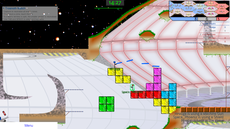IntersectingLineDetection — wiki
Here's some functions that I wrote to help with collision detection in a retro arcade remake of Asteroids using Python and Pygame. Some simple assertion tests are included at the bottom.
Features:
The entry point for an intersect test is the getIntersectPoint function.
# geometry.py
#
# Geometry functions to find intersecting lines.
# Thes calc's use this formula for a straight line:-
# y = mx + b where m is the gradient and b is the y value when x=0
#
# See here for background http://www.mathopenref.com/coordintersection.html
#
# Throughout the code the variable p is a point tuple representing (x,y)
#
# Copyright (C) 2008 Nick Redshaw
#
# This program is free software: you can redistribute it and/or modify
# it under the terms of the GNU General Public License as published by
# the Free Software Foundation, either version 3 of the License, or
# (at your option) any later version.
#
# This program is distributed in the hope that it will be useful,
# but WITHOUT ANY WARRANTY; without even the implied warranty of
# MERCHANTABILITY or FITNESS FOR A PARTICULAR PURPOSE. See the
# GNU General Public License for more details.
#
# You should have received a copy of the GNU General Public License
# along with this program. If not, see .
from __future__ import division
from pygame import Rect
# Calc the gradient 'm' of a line between p1 and p2
def calculateGradient(p1, p2):
# Ensure that the line is not vertical
if (p1[0] != p2[0]):
m = (p1[1] - p2[1]) / (p1[0] - p2[0])
return m
else:
return None
# Calc the point 'b' where line crosses the Y axis
def calculateYAxisIntersect(p, m):
return p[1] - (m * p[0])
# Calc the point where two infinitely long lines (p1 to p2 and p3 to p4) intersect.
# Handle parallel lines and vertical lines (the later has infinate 'm').
# Returns a point tuple of points like this ((x,y),...) or None
# In non parallel cases the tuple will contain just one point.
# For parallel lines that lay on top of one another the tuple will contain
# all four points of the two lines
def getIntersectPoint(p1, p2, p3, p4):
m1 = calculateGradient(p1, p2)
m2 = calculateGradient(p3, p4)
# See if the the lines are parallel
if (m1 != m2):
# Not parallel
# See if either line is vertical
if (m1 is not None and m2 is not None):
# Neither line vertical
b1 = calculateYAxisIntersect(p1, m1)
b2 = calculateYAxisIntersect(p3, m2)
x = (b2 - b1) / (m1 - m2)
y = (m1 * x) + b1
else:
# Line 1 is vertical so use line 2's values
if (m1 is None):
b2 = calculateYAxisIntersect(p3, m2)
x = p1[0]
y = (m2 * x) + b2
# Line 2 is vertical so use line 1's values
elif (m2 is None):
b1 = calculateYAxisIntersect(p1, m1)
x = p3[0]
y = (m1 * x) + b1
else:
assert false
return ((x,y),)
else:
# Parallel lines with same 'b' value must be the same line so they intersect
# everywhere in this case we return the start and end points of both lines
# the calculateIntersectPoint method will sort out which of these points
# lays on both line segments
b1, b2 = None, None # vertical lines have no b value
if m1 is not None:
b1 = calculateYAxisIntersect(p1, m1)
if m2 is not None:
b2 = calculateYAxisIntersect(p3, m2)
# If these parallel lines lay on one another
if b1 == b2:
return p1,p2,p3,p4
else:
return None
# For line segments (ie not infinitely long lines) the intersect point
# may not lay on both lines.
#
# If the point where two lines intersect is inside both line's bounding
# rectangles then the lines intersect. Returns intersect point if the line
# intesect o None if not
def calculateIntersectPoint(p1, p2, p3, p4):
p = getIntersectPoint(p1, p2, p3, p4)
if p is not None:
width = p2[0] - p1[0]
height = p2[1] - p1[1]
r1 = Rect(p1, (width , height))
r1.normalize()
width = p4[0] - p3[0]
height = p4[1] - p3[1]
r2 = Rect(p3, (width, height))
r2.normalize()
# Ensure both rects have a width and height of at least 'tolerance' else the
# collidepoint check of the Rect class will fail as it doesn't include the bottom
# and right hand side 'pixels' of the rectangle
tolerance = 1
if r1.width < tolerance:
r1.width = tolerance
if r1.height < tolerance:
r1.height = tolerance
if r2.width < tolerance:
r2.width = tolerance
if r2.height < tolerance:
r2.height = tolerance
for point in p:
try:
res1 = r1.collidepoint(point)
res2 = r2.collidepoint(point)
if res1 and res2:
point = [int(pp) for pp in point]
return point
except:
# sometimes the value in a point are too large for PyGame's Rect class
str = "point was invalid ", point
print str
# This is the case where the infinately long lines crossed but
# the line segments didn't
return None
else:
return None
# Test script below...
if __name__ == "__main__":
# line 1 and 2 cross, 1 and 3 don't but would if extended, 2 and 3 are parallel
# line 5 is horizontal, line 4 is vertical
p1 = (1,5)
p2 = (4,7)
p3 = (4,5)
p4 = (3,7)
p5 = (4,1)
p6 = (3,3)
p7 = (3,1)
p8 = (3,10)
p9 = (0,6)
p10 = (5,6)
p11 = (472.0, 116.0)
p12 = (542.0, 116.0)
assert None != calculateIntersectPoint(p1, p2, p3, p4), "line 1 line 2 should intersect"
assert None != calculateIntersectPoint(p3, p4, p1, p2), "line 2 line 1 should intersect"
assert None == calculateIntersectPoint(p1, p2, p5, p6), "line 1 line 3 shouldn't intersect"
assert None == calculateIntersectPoint(p3, p4, p5, p6), "line 2 line 3 shouldn't intersect"
assert None != calculateIntersectPoint(p1, p2, p7, p8), "line 1 line 4 should intersect"
assert None != calculateIntersectPoint(p7, p8, p1, p2), "line 4 line 1 should intersect"
assert None != calculateIntersectPoint(p1, p2, p9, p10), "line 1 line 5 should intersect"
assert None != calculateIntersectPoint(p9, p10, p1, p2), "line 5 line 1 should intersect"
assert None != calculateIntersectPoint(p7, p8, p9, p10), "line 4 line 5 should intersect"
assert None != calculateIntersectPoint(p9, p10, p7, p8), "line 5 line 4 should intersect"
print "\nSUCCESS! All asserts passed for doLinesIntersect"








